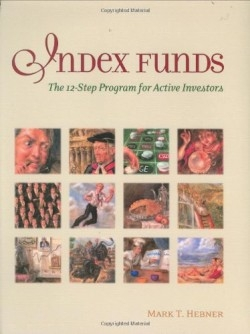Index Funds
The 12-Step Program for Active Investors
Using a 12-Step Program for Active Investors, author Mark T. Hebner delivers investing facts straight-up, with supporting quotes from Nobel Prize winners. The dozens of original art paintings throughout the book (by Lala Ragimov) lend humanity and humor to a serious and thought-provoking subject.
Hebner begins with the little-known fact that markets usually outperform managers, and he sets out to prove this conclusion in a modern, understandable, and intelligent book. After his “lack of understanding of how markets worked had cost me a mind-boggling amount of money,” Hebner researched his portfolio’s performance and realized his knowledge could help investors “break these destructive patterns of investing.”
Index Funds: The 12-Step Program for Active Investors begins with the Short Book on Investing. In this guide, Hebner helps readers understand 10 key concepts including The Random Walk Theory, Skill or Luck, Returns from the Risk of Capitalism Rank Highest, Small Value versus Large Growth, and more. The book’s designer incorporated Ragimov’s colorful illustrations and icons with an outline style that gives readers (especially visual learners) a clear understanding of how Hebner supports the book’s concept, quite possibly making it an excellent gift or coffee table book.
A successful businessman and “recovering active investor,” Hebner’s own active investing strategy cost him $30 million. The president of Index Funds Advisors in Irvine, CA, his flagship Web site, www.ifa.com, is currently considered the leading Internet source of information on index funds.
Although 90 percent of investors are active investors, and financial institutions and media perpetuate the false idea that some people (i.e., fund managers) have a gift or method for predicting future stock price gyrations, Hebner sets out to explain a study by Walter Good and Roy Hermansen. Three-hundred college students guessed the outcome of 10 coin tosses. The results were collected, tabulated, and charted. Then, the performances of 300 mutual fund managers were identified for a 10-year period (1987-1996). The results showed that the number of years the mutual fund managers were rated in the top 50% of fund managers and the ability of college students to correctly guess the outcome of a coin toss were nearly identical.
The author makes a profound argument for going against the common assumption that investors need to actively manipulate their portfolios in order to out-guess the unpredictable and random attributes of the movements of stocks, markets, managers, and styles.
Reviewed by
Joan Phelps
Disclosure: This article is not an endorsement, but a review. The publisher of this book provided free copies of the book and paid a small fee to have their book reviewed by a professional reviewer. Foreword Reviews and Clarion Reviews make no guarantee that the publisher will receive a positive review. Foreword Magazine, Inc. is disclosing this in accordance with the Federal Trade Commission’s 16 CFR, Part 255.

